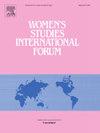Underrepresentation of female speakers at online and in-person dentistry conferences
IF 1.9
3区 社会学
Q2 WOMENS STUDIES
引用次数: 0
Abstract
We investigated the representation of female speakers at online dental conferences and in-person dental conferences. Our mains were: 1) to evaluate the representation of female and male speakers at in-person and online general dentistry conferences; 2) to evaluate the representation of female and male researchers in dentistry. We located the programs of online and in-person general dentistry conferences on the Internet. We identified the gender of the speakers as female or male. The data were analyzed with a Pearson chi-squared test and a Mann Whitney U test. For the online conferences, the female speakers represented 28.0 % (n = 26), and the male speakers represented 72.0 % (n = 67). For the in-person dental conferences, the female speakers represented 21.2 % (n = 50), and the male speakers represented 78.8 % (n = 186). The female-to-male speaker proportion was 1 to 3.76 for in-person conferences and 1 to 2.58 for the online conferences. We identified 375 researchers were registered in the National Research System, with 48.8 % (n = 183) being women and 51.2 % (n = 192) men. The underrepresentation of women was present at dental conferences. The participation of female speaker increased for online conferences, but the increase did not come close to equality.
在网上和面对面的牙科会议上,女性演讲者的代表性不足
我们调查了在线牙科会议和面对面牙科会议上女性演讲者的代表性。我们的主要工作是:1)评估在面对面和在线全科牙科会议上女性和男性演讲者的代表性;2)评估女性和男性研究人员在牙科领域的代表性。我们在互联网上找到了在线和面对面的普通牙科会议的程序。我们把说话者的性别确定为女性或男性。采用Pearson卡方检验和Mann Whitney U检验对数据进行分析。在在线会议中,女性演讲者占28.0% (n = 26),男性演讲者占72.0% (n = 67)。在面对面牙科会议中,女性演讲者占21.2% (n = 50),男性演讲者占78.8% (n = 186)。面对面会议的男女演讲者比例为1比3.76,在线会议的男女演讲者比例为1比2.58。我们确定在国家研究系统中注册了375名研究人员,其中48.8% (n = 183)为女性,51.2% (n = 192)为男性。参加牙科会议的妇女人数不足。在线会议中女性发言人的参与率有所增加,但这一增长并未接近平等。
本文章由计算机程序翻译,如有差异,请以英文原文为准。
求助全文
约1分钟内获得全文
求助全文
来源期刊

Womens Studies International Forum
WOMENS STUDIES-
CiteScore
2.50
自引率
7.10%
发文量
63
审稿时长
79 days
期刊介绍:
Women"s Studies International Forum (formerly Women"s Studies International Quarterly, established in 1978) is a bimonthly journal to aid the distribution and exchange of feminist research in the multidisciplinary, international area of women"s studies and in feminist research in other disciplines. The policy of the journal is to establish a feminist forum for discussion and debate. The journal seeks to critique and reconceptualize existing knowledge, to examine and re-evaluate the manner in which knowledge is produced and distributed, and to assess the implications this has for women"s lives.
 求助内容:
求助内容: 应助结果提醒方式:
应助结果提醒方式:


